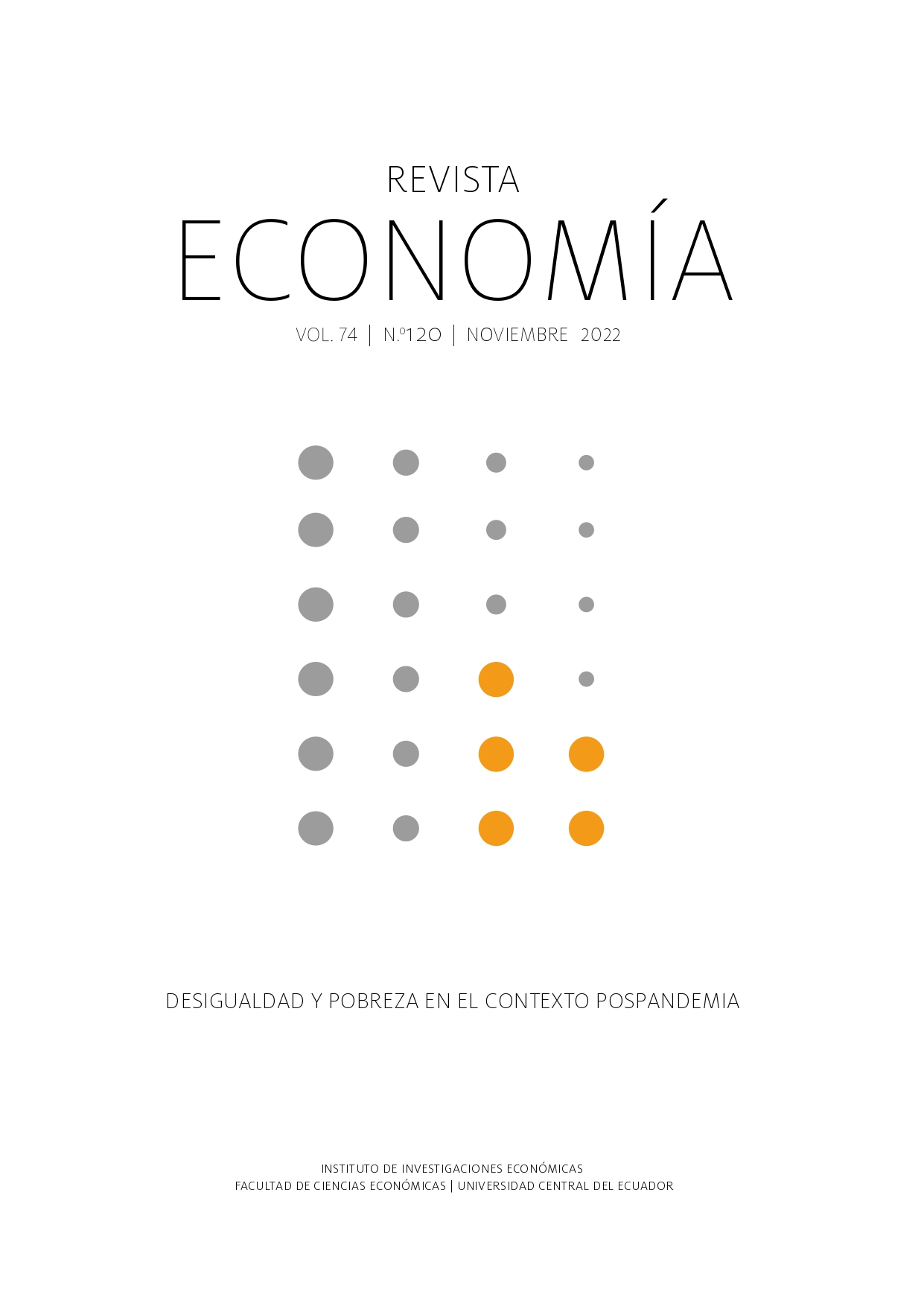Ecuador's export pattern in dollarization: New findings?
Main Article Content
Abstract
The objective is to identify the changes that the export pattern of Ecuador has experienced in dollarization. The analysis determines the shares of the groups of export products: primary versus industrialized, and petroleum versus nonpetroleum. New findings are also sought in the temporary triangles of foreign trade. Also, evaluate the Gini coefficient of exportable production. It is concluded that Ecuador has been immersed in a process of export diversification based mainly on primary non-oil production. It is presumed that it is possible to avoid the re-concentration of export production if the manufacturing industry is strengthened.
Downloads
Article Details

This work is licensed under a Creative Commons Attribution-NonCommercial 4.0 International License.
The authors who publish in this journal accept the following conditions:
- The authors retain the copyright and assign to the Economics Magazine the right of the first publication, with the work registered under Creative Commons Attribution-NonCommercial 4.0, which enables third parties to redistribute, commercial or non-commercial, of what has been published as long as the article circulates completely and without changes.
- Authors can make other independent and additional contractual agreements for the distribution of the article published in this journal (for example, add it to an institutional repository or publish it in a book) as long as they clearly and clearly specify that the article was published for the first time. once in Revista Economía. In case of reproduction, a note similar to the one presented below must be included: This text was originally published in the Revista Economía No.…, volume…, number of pages, year of publication.
- Authors are suggested to publish their work on the internet (for example, on institutional or personal pages) of the final version published by Revista Economía since this can lead to greater and faster dissemination of the published article.
References
Referencias bibliográficas
Acemoglu, D., & Zilibotti, F. (1997). Was Prometheus unbound by chance? Risk, diversification, and growth. Journal of political economy, 105(4), 709-751.
Acosta, A. y Cajas, J. (2018). Una década desperdiciada. Las sombras del correísmo. Centro Andino de Acción Popular (CAAP). https://www.researchgate.net/publication/331950747_Una_decada_desperdiciada_Las_sombras_del_correismo
Agosin, M. R. (1999). Comercio y crecimiento en Chile. Revista CEPAL.
Agosin, M. R. (2009). Crecimiento y diversificación de las exportaciones en economías emergentes. Revista Cepal.
Amurgo-Pacheco, A., & Pierola, M. D. (2008). Patterns of export diversification in developing countries: intensive and extensive margins. The World Bank.
Banco Central del Ecuador (BCE). (2022). Información estadística mensual (2046). https://contenido.bce.fin.ec/home1/estadisticas/bolmensual/IEMensual.html
Banco Mundial (2022). Base de datos del programa de comparación internacional. https://datos.bancomundial.org/indicator/NY.GDP.PCAP.PP.CD?locations=EC
Cadot, O., Carrère, C., & Strauss-Kahn, V. (2011). Export diversification: what's behind the hump?. Review of Economics and Statistics, 93(2), 590-605.
Comisión Económica para América Latina y el Caribe (CEPAL) (2013). Comercio internacional y desarrollo inclusive: construyendo sinergias. CEPAL. https://www.cepal.org/es/publicaciones/27975-comercio-internacional-desarrollo-inclusivo-construyendo-sinergias
Comisión Económica para América Latina y el Caribe (CEPAL) (2022). Anuario Estadístico de América Latina y el Caribe. https://www.cepal.org/es/publicaciones/47827-anuario-estadistico-america-latina-caribe-2021-statistical-yearbook-latin
Escobar, L. (5 de diciembre de 2021). Más de 30 productos no tradicionales ecuatorianos se abrieron mercado en el exterior este 2021 con certificados de calidad. Diario El Universo. https://www.eluniverso.com/noticias/economia/mas-de-30-productos-no-tradicionales-ecuatorianos-se-abrieron-mercado-en-el-exterior-este-2021-con-certificados-de-calidad-nota/
Ghosh, A. R., & Ostry, J. D. (1994). Export instability and the external balance in developing countries. Staff Papers, 41(2), 214-235.
Greenaway, D., Morgan, W., & Wright, P. (1999). Exports, export composition and growth. Journal of International Trade & Economic Development, 8(1), 41-51.
Krugman, P. (1980). Scale economies, product differentiation, and the pattern of trade. The American Economic Review, 70(5), 950-959.
Imbs, J., & Wacziarg, R. (2003). Stages of diversification. American Economic Review, 93(1), 63-86.
International Trade Center (2022). Estadísticas del comercio para el desarrollo internacional de las empresas. https://www.trademap.org/Product_SelCountry_TS.aspx
Lectard, P., & Rougier, E. (2018). Can developing countries gain from defying comparative advantage? Distance to comparative advantage, export diversification and sophistication, and the dynamics of specialization. World Development, 102, 90-110.
Mangabeira, R. (2011). La reinvención del libre comercio. La división mundial del trabajo y el método de la economía. Fondo de Cultura Económica (FCE).
Michaely, M. (1977). Exports and growth: an empirical investigation. Journal of development economics, 4(1), 49-53.
Paredes, G. (2015). Integraciones monetarias pasivas en Sudamérica. Buenos Aires: Ediciones Cooperativas.
Paredes, G. (2017). Ecuador: ¿Por qué salir de la dolarización? Santiago de Chile: Revista Cepal, abril (121), 149-168. https://repositorio.cepal.org/bitstream/handle/11362/41152/1/REV121_Paredes.pdf
Rodrik, D. (2005). Políticas de diversificación económica. Santiago de Chile: Revista Cepal, diciembre (87), 7-23. https://www.cepal.org/es/publicaciones/11077-politicas-diversificacion-economica
Rodrik, D. (2015). Premature Deindustrialization. NBER Working Paper, (20935). https://www.nber.org/papers/w20935
Salinas, G. (2021). Chile: A Role Model of Export Diversification Policies?. IMF Working Papers, 2021 (148).
Sannassee, R. V., Seetanah, B., & Lamport, M. J. (2014). Export diversification and economic growth: the case of Mauritius. World Trade Organization (WTO).
Stanley, D. L., & Bunnag, S. (2001). A new look at the benefits of diversification: lessons from Central America. Applied Economics, 33(11), 1369-1383.
Villón, J. (2021, 3 de abril). Pepino dulce de Carchi desembarca en la Unión Europea y los Estados Unidos. Diario El Universo, 4.

